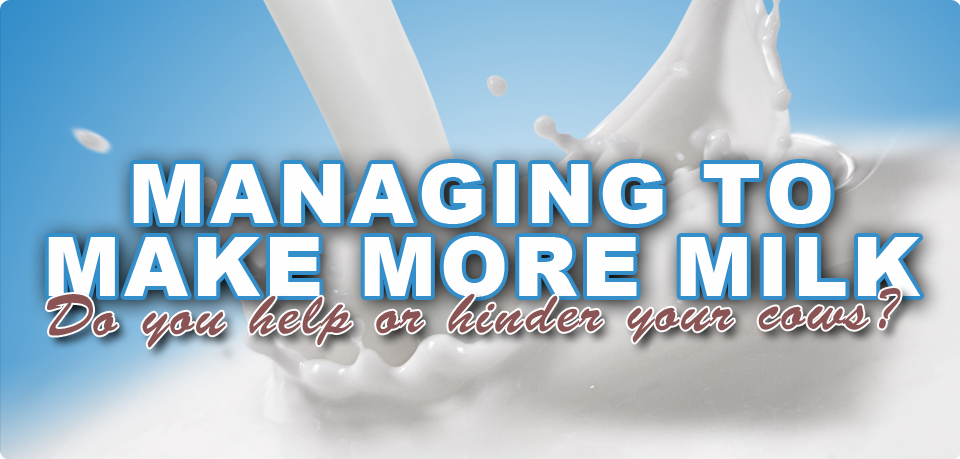Depending where you live, the last several years have put many pressures on dairy profitability. Margins are becoming slim to non-existent for some farms in 2012. Previously, one of the positive aspects of dairy farming was that dairy cows are good converters of by-products and low-cost feedstuffs that would otherwise be discarded. In today’s, challenged marketplace even these feeds are becoming more costly.
It’s Time to Look at Feed Conversion
Now the dairy industry must take a lesson from poultry, swine and beef who focus on feed efficiency in producing eggs, chicken, pork and beef. It’s time for dairy to focus on the conversion of feed to edible products.
The FE (Feed Efficiency) Formula
FE = Milk or FCM or ECM / dry matter intake
Feed efficiency in the dairy industry has traditionally been measured as some measure of milk production (actual milk, fat-corrected milk (FCM) or energy-corrected milk (ECM) as a ratio to dry matter intake.
The FCR (Feed Conversion Formula)
FCR = dry matter intake / lbs. of milk fat + lbs. of milk protein
The above is a new measure for feed conversion ratio (FCR), which is a measure of the pounds of feed (DM) that it takes to produce 1 pound of milk components.
Feed Efficiency is Not ONLY about FEED!
It would seem obvious that feed related factors would be most important when you set out to increase feed efficiency. Nutritionists and consultants draw our attention to forage digestibility, feed particle size, protein levels, fat levels, starch levels and certain feed additives that can affect feed efficiency. This is what they know. This is what we can control.
However, there are factors beyond feed that we can look at such as environmental factors and our own management inputs. Some environmental factors can be more difficult to control than others. It is difficult to be 100% in charge of the effects of heat stress, average days in milk, lactation number, acidosis and heat stress. Each one of these will affect feed conversion. But there are other environmental and management factors that we can target in our effort to improve feed conversion.
MANAGING TO MAKE MORE MILK: Do you help or hinder your cows?
Variability in management practices can greatly affect production, components and dry matter intake and, thus, feed efficiency. Researchers point to a survey which was undertaken on 3000 cows in 47 herds that were fed the same diet. Results show that there was a 27 pound difference in production (i.e. the difference between 47 pounds and 74 pounds of milk), even when fed the same ration.
Cow Comfort Should Not Be the Last Resort
A recent area under consideration for feed efficiency is cow comfort. Cow comfort issues can affect milk production and components, reproduction and general health. While most of the research has shown increases in production with improved cow comfort, generally production or component increases translate into improvements in feed efficiency. There are excellent studies on the effects of stall design on milk production and cow health.
Less Stocking density = More Milk
Too many cows in one area and the number of stalls per cow can have an effect on feed conversion. Cows in crowded conditions tend to eat faster and ruminate less. The larger numbers can directly relate to more pathogen load in the area. More pathogens can be as simple as more teat end exposure to pathogens. In the long term cows can share more serious illness and immune suppression. The previously mentioned Spanish study, attributed a 32 percent of the production variability to stocking density and determined that each 10 percent reduction in cows per stall equaled 1.7 lbs more milk per cow.
Less Lameness = More Milk
Lameness can dramatically affect production, health and reproduction. However, even cows that are mildly lame (cows that walk with shortened strides, an arched back and a slight limp) can have reduced production and feed efficiency.
Researchers have shown even cows with a lameness score of 3 (mildly lame, 1 to 5 scale with 5 being severely lame), can have 3 to 5 lbs less production (greater than 900 lbs per lactation) vs. sound cows (score 1). Key point – Even mild lameness can negatively impact production and feed efficiency.
More Lying time = More Milk
Cows need time to lie down. This priority can consume around 12 hours of a cow`s day and cows will sacrifice eating time for lying time. The Miner Institute in New York conducted a series of studies that showed an increase of 2 to 3.5 lbs of additional milk for each additional hour of lying time. More rest = More dollars.
Less Time Away from the Pen = More Milk
Minimizing time outside the pen is important to maximize cows’ time for resting, eating and drinking. Time away from the pen for milking can have an effect on production. In an extreme example of this, a study from the University of Nebraska compared the effect of three versus six hours per day away from the pen for milking. When time away from the pen was reduced, second-plus lactation cows gained two additional hours of resting time and 5 lbs of milk and first-lactation heifers gained an additional four hours of rest and 8 lbs of milk.
The Bullvine Bottom Line
These are only a few of the factors that have an impact on our cattle and their production levels. Knowing how to balance the need for resting, drinking, exercise, feeding and general comfort can have as much or more impact on feed efficiency than feed related factors alone. It only makes sense to control what we have some control over.

















Leave a Reply
You must be logged in to post a comment.